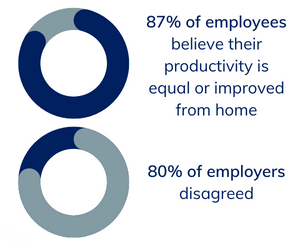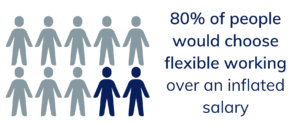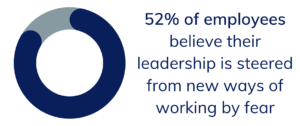Time in offices and formal workplaces has reduced significantly. Work patterns, connectivity, culture and engagement have seen seismic shifts, over a very short period of time. Disruptive and challenging for some, but undeniably beneficial for others.
As executive search professionals, we talk daily to leaders and employees across multiple functions, industries and geographies about their business, teams and people. Whilst last year was the major time of adjusting to a new normal, the challenge to create workplaces for the long term still exists which is why we wanted to find a way to capture and help share the key themes of the many conversations we have.
So since the beginning of 2022, we have been asking our network various questions, as both employers and employees. Over 7,000 responses and many conversations later, we wanted to share the key highlights and help you and your leadership teams benefit from the data and experience of others.
Collaboration and Connectivity: The challenge for employers in a flexible workplace

We have noticed a clear disconnect between business leaders and employees when asked about the challenges, benefits and preferences of a more flexible work pattern. It wasn’t, therefore, a surprise to read a recent article that reported 87% of employees felt their productivity was as good if not better working from home, while in contrast 80% of employers disagreed.
In our own surveys, almost half (46%) of leaders responded with ‘quality of connectivity’ when asked about the greatest challenge brought about by a more dispersed workforce. However, interestingly, leaders do also recognise that the biggest benefits of flexibility are to ‘staff wellbeing’ with 44% of respondents voting it as the most influential factor to their business performance over. Chosen over ‘staff autonomy and engagement’ (19%), ‘access to a wider talent pool’ (26%) and the assertion that there had been ‘no impact on business performance’ (12%).
Organisations have embraced the opportunity to be fully remote for the first time, but the pendulum has most certainly begun to swing back towards the office and 34% of our respondents recently told us that their business has now mandated 3 or more days in the workplace. And while 45% of respondents describe working from home as life changing, less than a third (31%) of employees expressed a desire to work remotely full time.
It’s quite a balancing act to overcome.
Leaders are clearly recognising the need to be more flexible and avoid a return to the legacy work patterns of old. Many, though, are struggling with how these adjusted variables now intersect with performance, staff development, engagement, collaboration and the purpose of the physical office itself. Most businesses have now benefitted from the flexibility and speed that virtual interviews have brought to their recruitment processes, but it’s clear that onboarding and training is more challenging. New employees are finding it harder to build informal and cross divisional relationships and leaders are struggling with the effective development of junior staff without proximity and oversight as their aids.
 The conundrum is broader than effectiveness and productivity though. In two separate surveys we found that ‘flexible/hybrid working’ (80%) and ‘a four-day working week’ (75%) were the most desirable or attractive benefits, well ahead of ‘a salary 10% above market rate’. This may of course change as the cost-of-living crisis bites harder, but unsurprisingly flexibility is a clear advantage in attracting and retaining talent.
The conundrum is broader than effectiveness and productivity though. In two separate surveys we found that ‘flexible/hybrid working’ (80%) and ‘a four-day working week’ (75%) were the most desirable or attractive benefits, well ahead of ‘a salary 10% above market rate’. This may of course change as the cost-of-living crisis bites harder, but unsurprisingly flexibility is a clear advantage in attracting and retaining talent.
So, consider the true purpose of the workplace for your business and the individuals within it. What is best done together, in person, at the office?
Who benefits most and just as importantly, least, from commuting to the office. How does this adjust with the time of day and could we adapt to make sure office time suited everyone? The message seems clear from employees; listen, observe and respond to the needs of each circumstance and use connectivity as a strategic tool, not a monitoring device.
Culture: A priority more now than ever
We’ve noticed the prominence of the word ‘culture’ has increased significantly in our conversations since the pandemic. Historically, people have consciously or unconsciously used the word culture to describe the office environment, the way colleagues interact with one another and the general buzz of the workplace. As this has shifted further away from physical presence and in person dialogue, culture has inevitably evolved.
 This may account for why, despite a clear preference to spend less time in the office, 88% of respondents cited a business’ culture as ‘key or crucial’ when searching for a new job. In a separate survey, 30% said that simply ‘chatting to colleagues’ was the thing they missed most about being in the office full time. Our clients also report an increase in energy and collaboration when people are together. Not only that, but body language also adds to the conversation which now includes the important subject of mental health. Togetherness, belonging and support is as vital as ever.
This may account for why, despite a clear preference to spend less time in the office, 88% of respondents cited a business’ culture as ‘key or crucial’ when searching for a new job. In a separate survey, 30% said that simply ‘chatting to colleagues’ was the thing they missed most about being in the office full time. Our clients also report an increase in energy and collaboration when people are together. Not only that, but body language also adds to the conversation which now includes the important subject of mental health. Togetherness, belonging and support is as vital as ever.
Culture therefore needs to be built from attitudes, purpose, common goals, ways of working and communication. Open mindedness, inclusivity, empowerment, clear expectations, appropriate structures and processes all contribute to culture, yet few are defined by presence. Strong and respected leadership remains key to any organisation, but servant-leadership and the ability to tune in to the needs of your colleagues and provide them with the scope to define the culture themselves is a real skill.
Is the challenge creating the patterns or the mindset around flexibility?
Previously, office culture was static with very little change over generations. We’ve seen the introduction of perks like office gym facilities, laundry services and even hairdressers over the years but they tended to keep us at the office longer, not create truly significant benefits to work-life balance.
Now though, we seem firmly in a world in which office culture will never be still or ‘finished’. It is going to be an ever-evolving concept as lifestyles change and employees prioritise their individual needs and how work fits into them, not the other way round. Overlay that with low unemployment, talent shortages and rising costs and it is a relatively straight forward conclusion; businesses that listen and stay flexible are likely to attract and retain the best people.
 One of the most interesting surveys we conducted asked workers to select the reason that they felt best described their leadership’s hesitance to trial new work patterns. Over half (52%) selected ‘fear of the unknown’.
One of the most interesting surveys we conducted asked workers to select the reason that they felt best described their leadership’s hesitance to trial new work patterns. Over half (52%) selected ‘fear of the unknown’.
Taking the opportunity to create environments and work patterns catered to the employee is a huge opportunity for the organisations that get it right. Those businesses will not only retain the best staff but will also be able to recruit from a wider, more diverse talent pool. Diverse in all sense of the word, not just gender and ethnicity, but physical ability, home location, neurodiversity and age.
A more diverse business is now proven to deliver greater business results. Couple this with its impact on inclusion, personal wellbeing and professional or social mobility and we think it paints a very exciting future.
bpesearch is a UK based executive search firm delivering search mandates at board and functional leadership level across the UK and Western Europe. Our clients range from owner-managed, VC or PE backed businesses to major plc multinationals. We’re at our best supporting change or transformation agendas where new thinking and diverse talent is part of the brief and company vision.
We’re committed to promoting diversity and we are working hard to improve the landscape for our colleagues, candidates and clients. There is much more for us to do, but we’re proud to report that women have secured 50% of all assignments we have led since the beginning of 2018. Over the same period, the proportion of successful candidates from under-represented ethnic groups has increased from 3% to 7%.
If you would like to discuss this article, your talent needs or personal situation with any of our team, please don’t hesitate to get in touch for a confidential conversation.






































